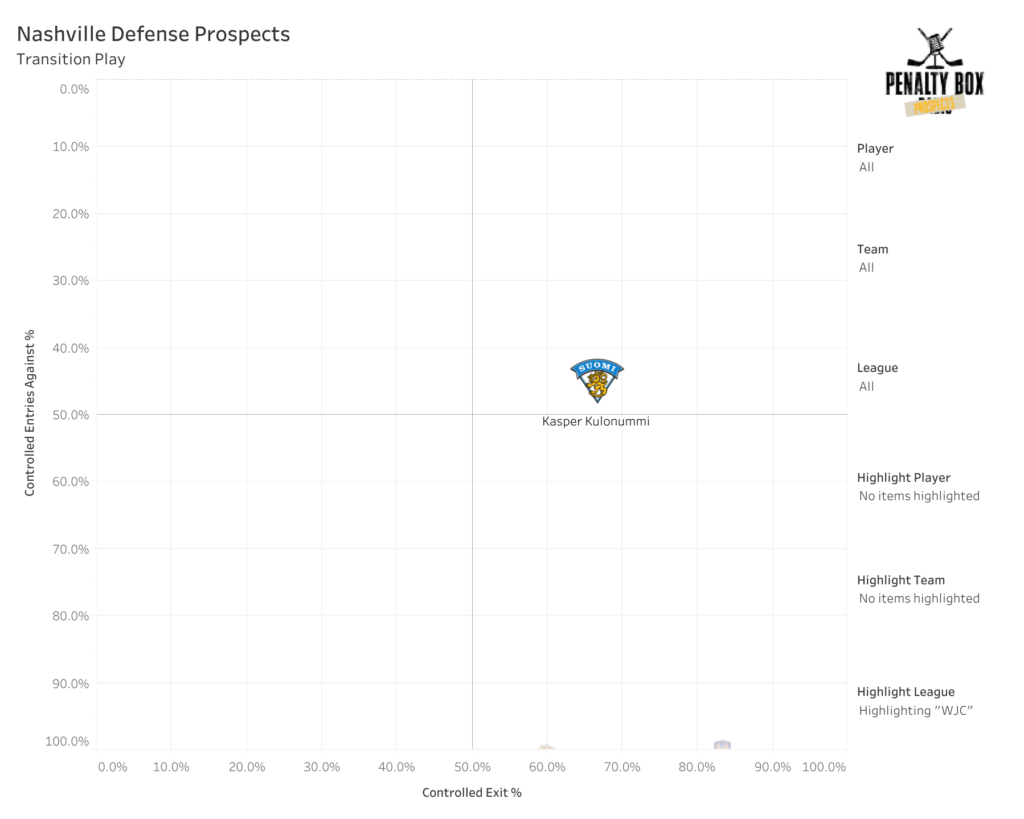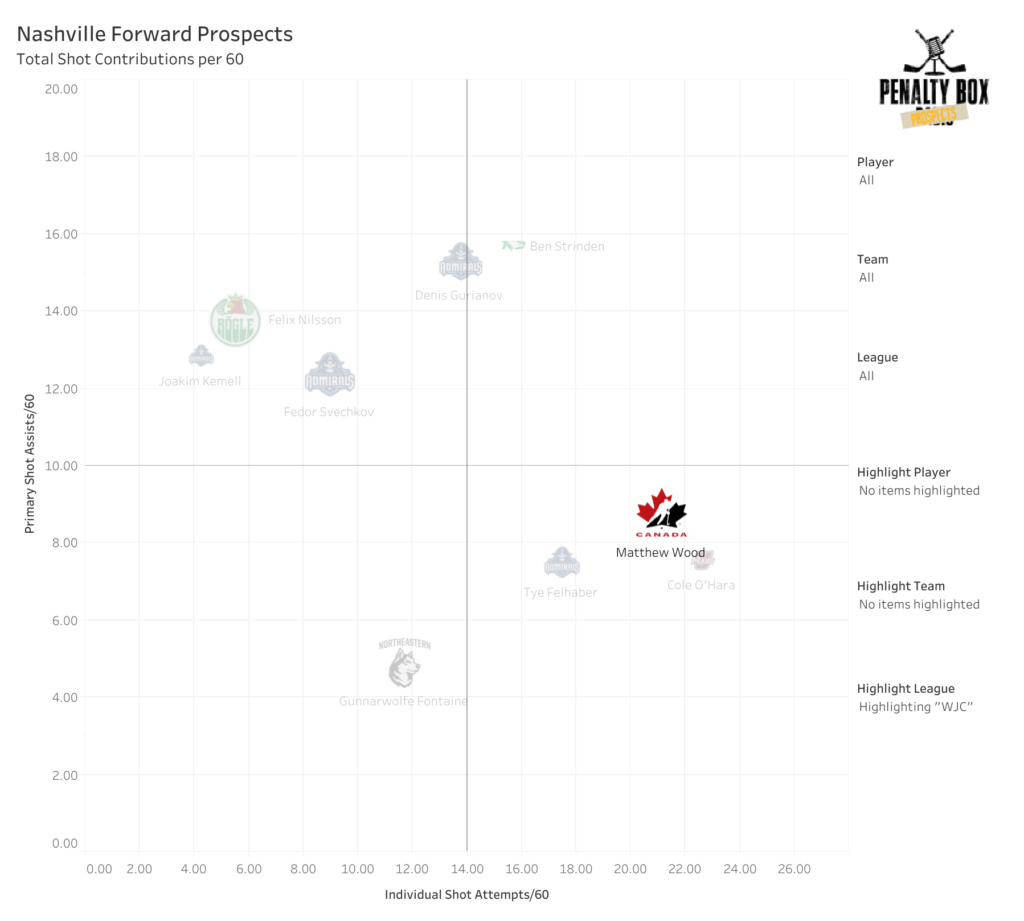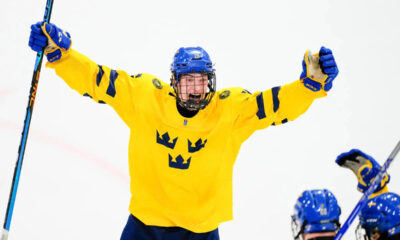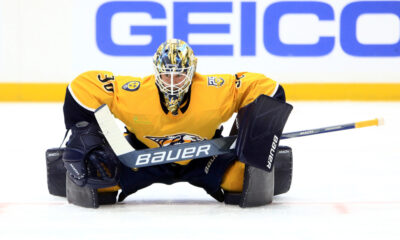The 2024 installment of the World Junior Championship (WJC) was yet another impressive showcase, featuring two Nashville Predators prospects: Kasper Kulonummi and Matthew Wood.
Despite medal hopes for both Kulonummi’s Finland and Wood’s Canada, both teams fell short of expectations. Canada was stunned by Czechia in the quarterfinals, and Finland fell to the United States in the semifinals before blowing a late lead to Czechia in the bronze-medal game.
The two Preds prospects entered the tournament with different roles. Kulonummi was expected to be Finland’s workhorse defender and was, leading them in ice time in all situations; Wood, on the other hand, battled for regular ice time in Canada’s deep lineup but ultimately finished tied for third on the team in scoring.
While performances at the WJC aren’t indicative of larger trends in a prospect’s development, I do think they can provide some insight into the strengths and weaknesses a player is currently working through. And that goes for Kulonummi and Wood at this year’s tournament.

In seven games, Kasper Kulonummi pitched in two primary assists and four total points while averaging 22:04 of ice time per game (the only Finnish player to eclipse 20 minutes). At even strength, Kulonummi finished with a 63.05% Corsi and contributed heavily to his team’s offense, posting 11.88 shot attempts and 9.41 primary shot assists per 60 minutes.

Kulonummi’s defense was solid too. He allowed a zone entry on just 45.00% of the attempts against him and kept more than half (55.56%) of those entries to the perimeter. In transition, Kulonummi led a successful zone exit on two-thirds of his attempts, skating the puck out himself 37.50% of the time.
As shown above, Kulonummi (#6, blue) took transition opportunities to show off his strong skating skills and up-ice vision, weaving through opponents and gaining the offensive zone.
Even when passing the puck out of his defensive zone, Kulonummi often displayed good patience with the puck, scanned his options well, and used his stickhandling to deceive opponents until it was too late.
In many cases though, Kulonummi’s offensive activations led to shot attempts from him coming from low-danger areas. The Finnish Liiga may not be the place for him to generate chances closer to the net (at least in his rookie year), but this contest against his peers should be.
On defense, Kulonummi managed his gaps well. He wasn’t perfect, getting out-muscled and out-positioned here and there, but when he played tight at the blue line, he was often successful at dislodging possession before any major offensive chances occurred.
When opponents dumped the puck in, Kulonummi often made plays with his usual style of defense, pinning puck carriers against the wall and buying time for his teammates to recover possession—even when he was initially beaten by faster skaters.
As the tournament went on, Kulonummi got more aggressive offensively, chipping in with puck touches lower in the zone. That culminated in him recording two primary assists in the bronze-medal game, including the nice play he makes in the clip above.

For Team Canada, Matthew Wood struggled to earn regular ice time, but he still recorded two goals and four points in five games. He scored 2.91 goals per 60 minutes and 5.28 primary points per 60 minutes of even-strength ice time all while averaging just 8:15 per game.
Wood was a positive possession player, recording a 58.11% Corsi rating. His offensive instincts were hard to deny as he peppered opponents with 21.13 shot attempts, including 10.57 high-danger attempts, and 8.81 primary shot assists per 60 minutes.

When moving up the ice with the puck, Wood almost always chose to skate the puck in, opting to do so 88.89% of the time; he was successful on 68.75% of those chances, using his frame to ward off opposing defenders.
Wood (#18, black) doesn’t have a ton of game tape to dive into, and it’s hard to deny he looked uncomfortable at times—perhaps due in part to the bigger ice. That uncomfortably sometimes extended to his stickhandling, his playmaking, and the off-puck anticipation I’ve seen him play with in college. But as the tournament went on, Wood improved, playing undoubtedly his best game against Czechia in the quarterfinals.
Off the puck, Wood showed some good flashes on the forecheck, including the shift above against Sweden. He pressured opponents tenaciously, forcing rash passes, stifling offense, and contributing to opponents’ giveaways.
Wood also showed some good defensive instinct too, taking good angles against opponents’ breakouts and using his size and reach to disrupt offensive chances.
Wood’s usual offensive prowess was on display on the power play and at even strength, including the impressive stretch pass shown above and his laser of a shot shown below.
While Matthew Wood is eligible to return to next year’s World Juniors, Kasper Kulonummi will be aging out. But both have important things to prove for the rest of this season.
For Wood, he’ll need to show he’s a truly dominant college hockey player that Nashville will want to sign sooner rather than later. And for Kulonummi, developing a more well-rounded game in his first pro season will go a long way toward his NHL projection.

















